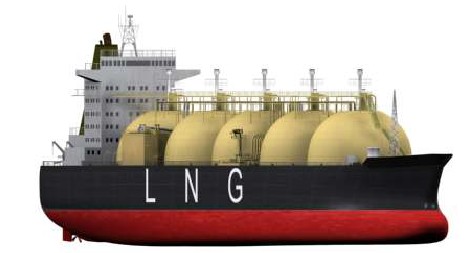

Home page|||
LNG handling |||
LPG handling||| Other Gas products|||
Fire & Safety|||
Emergency response |||
Why LNG is stored in a unpressurized tank ? Is it safe ?
Liquefied natural gas is transported in double-hulled
ships designed to prevent leakage or rupture in an accident. For most LNG carriers, the cargo is stored in
either membrane containment systems made of special
materials or in spherical tanks located within the ship's
inner hull. For membrane containment systems, a complete secondary containment system surrounds the primary container. The insulation space between the two
has sensing equipment able to detect even the smallest
presence of methane (the main component of natural
gas), possibly indicating a leak of LNG .
LNG is stored unpressurized at an extremely cold
temperature (-260 degrees F). Should a tank ever fail
and a leak result, fire is possible, but only if there is the
right concentration of liquefied natural gas vapor in
the air and a source of ignition. Since such a combination rarely exists, explosions are highly unlikely.
LNG is not explosive, Although
a large amount of energy is stored in LNG, it cannot
be released rapidly enough to cause the overpressures
associated with an explosion.LNG
vapors (methane) mixed with air are not explosive in
an unconfined environment.

Fig:LNG carrier moss tanks
LNG ships have emergency shutdown systems that
can identify potential safety problems and shut down
operations. This significantly limits the amount of liquefied natural gas that could be released. Fire and gas
detection and fire fighting systems help address the
risk of fire. Special operating procedures, training,
and maintenance further contribute to safety.
LNG vessels also have equipment to make ship handling safer. This equipment includes sophisticated
radar and positioning systems that enable the crew
to monitor the ship's position, traffic, and identified
external hazards. A global maritime distress system
automatically transmits signals if an onboard emergency occurs that requires external assistance. In
addition, some LNG ships use velocity meters to
ensure safe speeds when berthing. When moored,
automatic line monitoring helps keep ships secure.
When connected to the onshore system, the instrument systems and the shore-ship LNG transfer system act as one, allowing emergency shutdowns of
the entire system both from ship and from shore.
LNG is a cryogenic substance and its main component is methane. It gasifies violently when directly introduced into a cargo tank at ambient temperature, rapidly increases the internal pressure of the cargo tank and makes the atmosphere into a flammable condition.
In addition, the cargo tank is rapidly cooled, resulting tremendous thermal stress on cargo tank skins and cargo piping systems. To avoid such damages, the preparatory work for cargo loading after dry docking must be done in the following sequence.
During dry dock all the compartments of an LNG carrier are kept gas free. After leaving the dry dock the vessel has to be prepared to load cargo, for that the following points to be considered with priority.
- Preparation for loading LNG cargo
- Procedures for LNG cargo loading
- Procedures for LNG cargo discharging
- Liquefied gases - How to remove all cargo liquid from tanks
LNG spill risk during marine transportation and hazards associated
How to tackle fire on board LNG ship
Fire fighting plan for LNG cargo
External links :
-
Oregon LNG Import Terminal Operations

// Home page///
LNG handling ///
LPG handling///
Sea transport ///
Gas products///
Cargo work
///Fire precautions
///Health hazards
///Safety Precautions
///Emergency response ///

Copyright © Liquefied Gas Carrie.com All rights reserved.
The content published in this website are for general reference only. We have endeavoured to make the information
as accurate as possible but cannot take responsibility for any errors. For latest information please visit www.imo.org .
Any suggestions, please Contact us !
///Links &Resources //
Terms of use///
Privacy policy///Home page///

